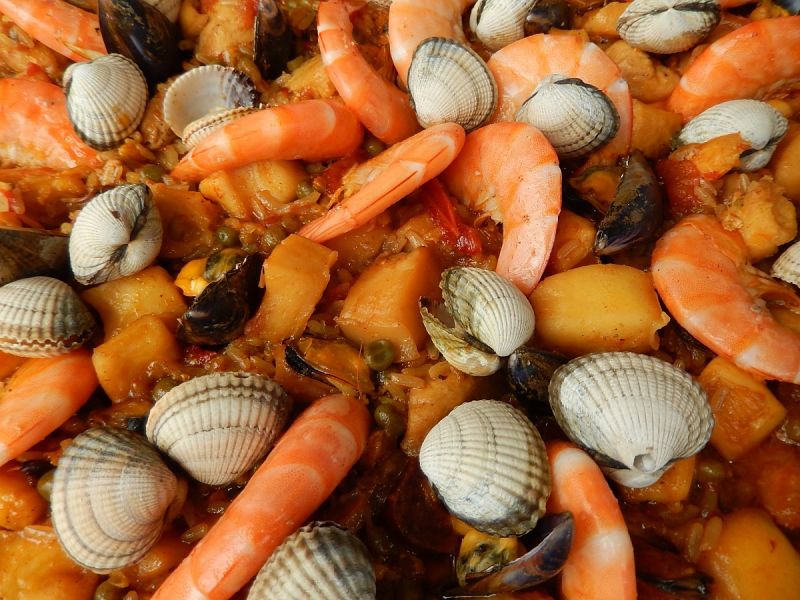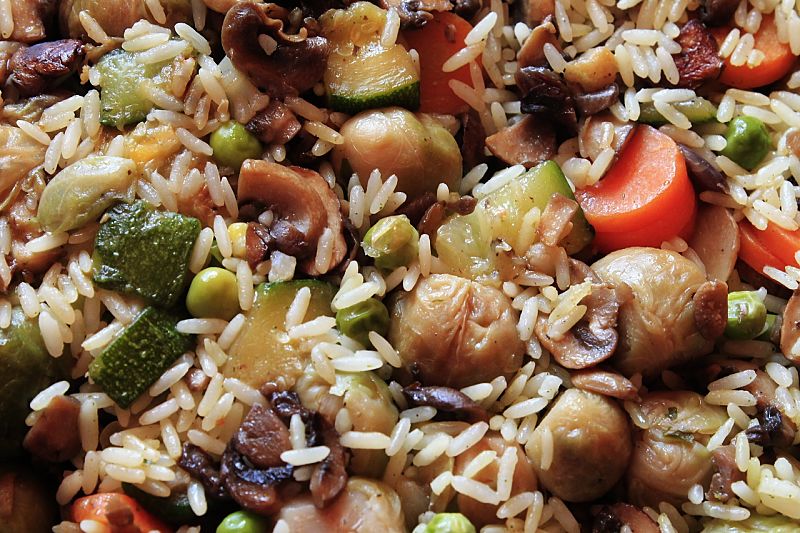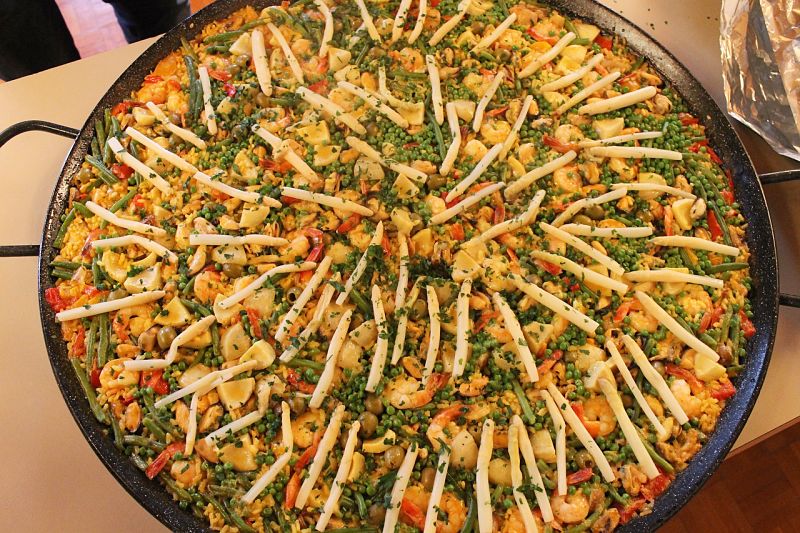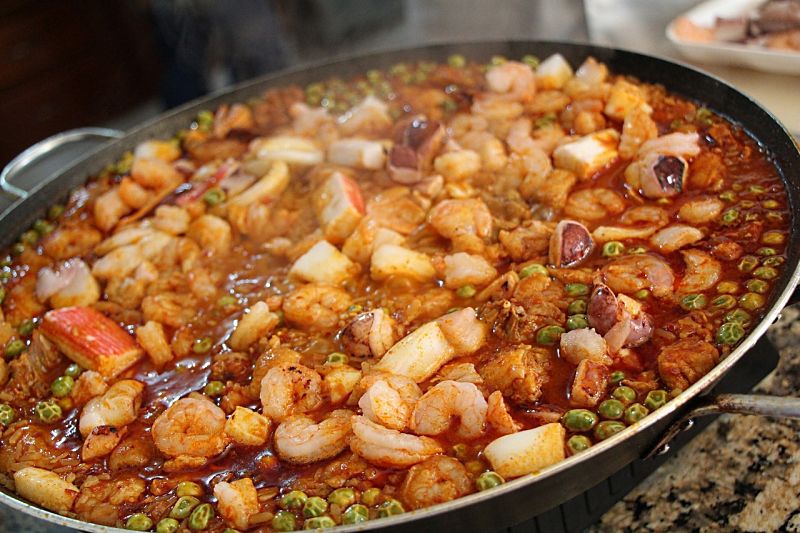Best Paella Recipes, Seafood and Chicken : Make Perfect Paella
Paella is a classic iconic Spanish dish, that shares the same passion for Spaniards that Italians have for pizza and pasta. But, although it is a relatively simple dish, it can be hard to get it right every time. Paella, like risotto and fried rice, can be very disappointing if things go wrong. The key is to learn to cook the rice properly so that it absorbs the flavors in the dish without becoming a soggy mess.
This article includes the best tips for making perfect paella at home and some fabulous recipes to try. Paella is prepared by simmering fresh seafood and sometimes chicken with rice, vegetables, herbs, saffron and other spices. There are many different variations. Start by mastering the best ever recipes provided later in this article and then try your own variations.
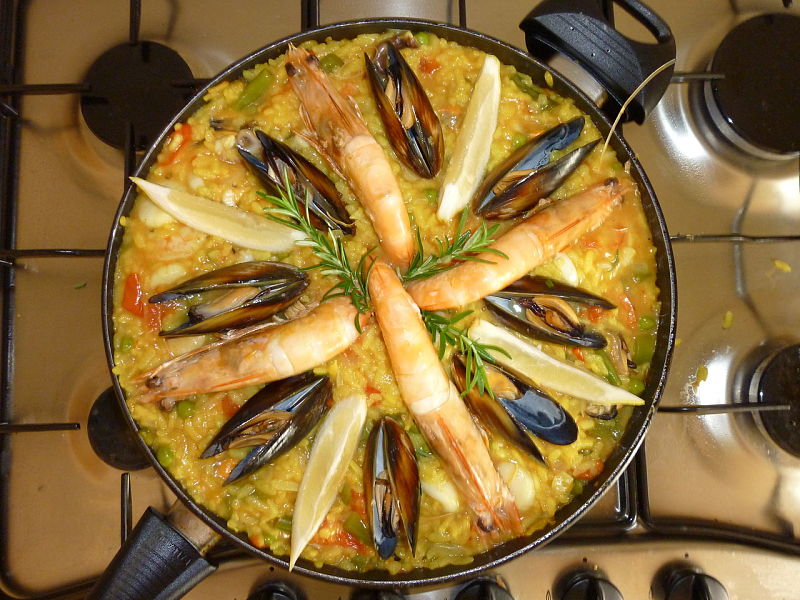
Tips for Making Perfect Paella
► Choose the Ideal Pan for Paella
A proper paella pan, is not absolutely necessary, but it helps. The classic carbon steel paella pan, like a steel wok requires care and patience to develop a patina over time that stops it rusting. This classic pan adds a unique extra flavour to the dish. These days there are many excellent stainless steel paella pans with a round flat or slightly dimpled base. But you can use a large flat and wide frying pan with a thin base. The base has to be thin to conduct heat quickly to the rice and cause steam and evaporation while it cooks. For a large pan it is important that the base position over a single burner is rotated to control the distribution of the heat. A wok burner is ideal for this purpose.
► Prepare the Ingredients in Advance
Paella is actually a home cooked meal and it can be ready in about 20 minutes. But it is important to have all the ingredients prepared and laid out on your bench before you start. You don't want to be delayed by having to look for spices or other ingredients as the timing during the cooking is critical.
► Sofrito - the Heart of a Good Paella
The sofrito is the aromatic core of a good Paella. It consists of the tomatoes, paprika, saffron, oil, chives, parsley, garlic, piquillo peppers and other herbs and spices that provide the texture to a paella and create the rich flavor and aroma for the dish. One tip is to combine all these ingredients using a food processor or blender. While this is not the traditional way of preparing a sofrito it is a quick and easy way to combine all the ingredients and to release the aromatics from the spices. This removes all the drama and complexity of trying to make the sofrito by adding the ingredients to the stock.
► Ideal Type of Rice for Paella
Like risotto, using the wrong type of rice can be disastrous. The texture and size of the grains is critical for timing the cooking process.
Short-grain rice is the best as it absorbs the stock quickly and easily and it won't dry out.
However, unlike risotto, the rice in a paella should not be stirred.
It is worth searching for authentic Spanish Bomba rice which absorbs almost twice as much stock as regular short grain rice varieties without becoming soggy and mushy. Bomba grains retain their shape, even when slightly overcooked. Other suitable Spanish rice varieties are bahfa, senia and thaibonnet. You can also use arborio, and other short grain rice varieties suitable for risotto. It is very important to use the right type of rice in a paella, otherwise it could fail. Avoid long grained rice which doesn’t have the right texture and is less absorbent.
► Soccarrada the Elusive Golden Crust
The soccarrada is the crisp, golden layer that forms on the bottom of a paella when it is cooked without stirring.
It is regarded as a highly prized Spanish delicacy that separates the average Paella maker from the master home chef.
A soccarrada oozes the color, aroma and taste of the caramelised garlic, paprika and other ingredients that are concentrated in
the crisp 'skin' on the bottom of the pan. In Spanish households the children always fight for the soccarrada.
The secret to developing the soccarrada is to wait until all the stock in the pan is gone. Then, turn the heat and cook it on high for an extra 2 minutes, and then turn the heat off and let the pan rest it for 5 minutes. During this resting period the concentrated flavors activated by the extra heat will flow down and form a golden layer on the bottom of the pan.
► Stock for Paella
The best stock for paella is a homemade chicken, fish or seafood stock (made with prawn heads). But you can use a good quality commercial stock.
► Saffron - A vital Ingredient
You cannot make a perfect paella without saffron, which provides the inspiring color and blends the spices and other flavors in the paella together. The saffron should be infused in a tiny amount or hot water or stock for 15-20 minutes before being added to the paella.
► Do not Over Crowd the Dish with Too Much Seafood, Chicken or Vegetables
There are many delightful variations to try by adding meat and vegetables, but rice should remain the prominent ingredient in a perfect paella.
Use secondary ingredients to add flavour and intrigue, but they should never dominate the dish.
Use tasty meats such as fish pieces, mussels, clams, shrimp, scallops and other seafood, bacon, ham, chorizo and chicken.
But, use these additions sparingly.
Also, all the meat ingredients should be cooked and browned in a little olive oil before adding to the paella. You can use an array of vegetables and herbs, but add them sparingly. You can use grilled capsicum, artichokes, beans, carrots, peas, and cooked pieces of zucchini, eggplant, olives. caramelised onion can be added along with a variety of fresh herbs such as a rosemary and coriander.
► Final Secrets for a Perfect Paella
The key is to carefully watch how the rice is cooking. Boil the mixture for about 15 minutes, or until the rice grains have started to plump up and much of the liquid has evaporated and then lower the heat to very low. Some chefs cover the paella with foil. Cook slowly until the mixture starts to dry a little and a sample of the rice grains are cooked. Before serving in the pan, raise the heat to high for the last few minutes to develop the golden socarrat. Finally, remove the paella from the heat, cover with a tea towel and set aside for 5-10 minutes to fully settle the flavors and finalise the socarrat.
► Common Problems and Solutions When Making Paella
The two common mistakes that people make are, overcrowding the pan, and not adding enough stock to the dish, so that the rice cannot cook properly. If you overcrowd the pan and the mixture is too thick, the rice will only cook at the bottom. You deliberately need to use a large flat pan to ensure the mixture is thin, so that it will cook properly. A large quantity of mixture needs a very large pan.
Don't be afraid to add more stock if the liquid evaporates before the rice is cooked properly. Always remove a little rice and taste it to see how it is going. Don't forget to rest the pan after the rice is cooked to fully develop the flavors.
► Tips for Cleaning a Paella pan
Do not scrub or scrape a paella pan, especially the older style carbon steel one. Wash it carefully with hot water and a little detergent to clean it well and dry it on a warm stove. Add a tiny bit of olive oil so the carbon steel does not rust.
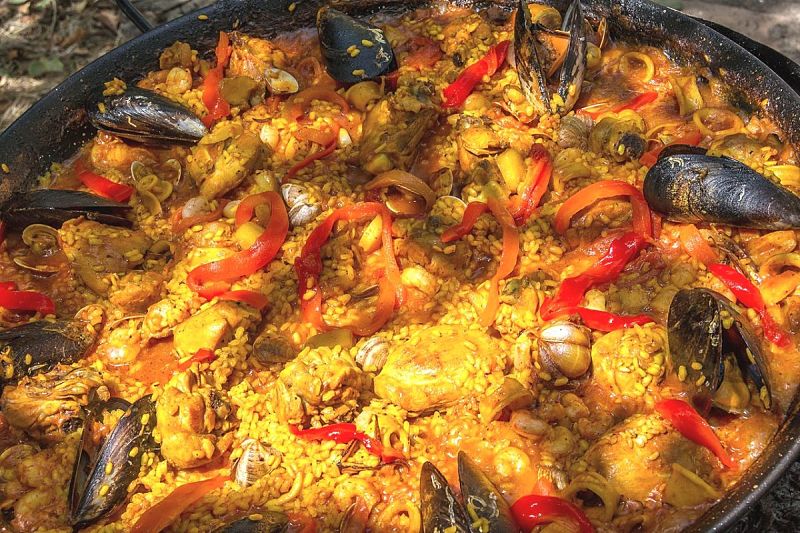
Mixed Seafood and Chicken Paella
Ingredients
- 500 ml (1 pint) chicken stock
- Aioli and Sangria, for serving
- 50 g (2 oz) fresh or frozen peas
- 220 g (7 oz) Bomba rice, or similar
- 2 tablespoons extra virgin olive oil
- 1/2 bunch chives, to use as a garnish
- 1 lemon, sliced into wedges, for serving
- 500 g (1 lb) mixed fresh seafood (fish, calamari, clams, mussels, prawns, scallops)
For the sofrito
- 1 bunch fresh chives
- 1/2 bunch fresh parsley
- 1 pinch saffron threads
- 1 tablespoon smoked paprika
- 6 piquillo peppers, or similar
- 25 ml (1 fl oz) extra virgin olive oil
- 2 large ripe tomatoes, sliced roughly
- 4 garlic cloves, peeled, finely chopped
Method
Employ a quick and easy way of preparing the sofrito by first placing all the sofrito ingredients listed above into the bowl of a blender or food processor. Pulse several times to chop and combine the ingredients, leaving them chunky. The sofrito ingredients can also be prepared by hand, after finely chopping all of the ingredients. Place the sofrito in a small pan and using moderate heat, cook and blend the ingredients and thicken by stirring and allowing about half of the liquid to evaporate. Assembly all of the other ingredients to prepare for the final assembly and cooking.
To cook the paella place a large paella pan or shallow thin metal frying pan on the stove over high heat. Add a slash of olive oil and stir fry the mixed seafood until just cooked (about for one minute). Add sofrito to the pan and cook while stirring for a further 3 minutes. Add chicken stock and stir to combine well. Bring the mixture to the boil and then add the rice. Heat for several minutes until the rice grains start to plumb. Lower the heat and simmer for 15 minutes, without stirring, until almost all of the stock has absorbed. Add the peas and other vegetables and herbs and cook for a further 2 minutes. Then, turn up the heat to high for several minutes the develop the soccarrada crust on the base of the pan. Remove the pan from the heat and let the paella rest, covered, for 5-10 minutes. Season to taste with salt and freshly ground black pepper, and serve with a squeeze of lemon juice, fresh herb garnishes, and some sangria and aioli.

Easy Paella Recipe
Ingredients
- salt to taste
- A pinch of saffron
- 100 g (3.5 oz) peas
- 2 tablespoons olive oil
- 1 leek, finely chopped
- 2 strips of orange zest
- 2 teaspoons smoked paprika
- 1 kg (2 lb) mussels, cleaned
- 1 red pepper, finely chopped
- 2 onions, very finely chopped
- 1 pinch of dried chilli flakes
- 4 garlic cloves, finely chopped
- 2 celery sticks, finely chopped
- 1/2 cup parsley, coarsely chopped
- 150 g (5 oz)cooking chorizo, sliced
- 400 g (14 oz) paella rice, or similar
- 100 g (3.5 oz) french beans, chopped
- Freshly ground black pepper to taste
- 200 g ( 7 oz) squid, cleaned and sliced
- 400 g (14 oz) boneless chicken thighs, cut into 3 slices
- 1 litre chicken stock or fish stock (homemade preferred)
Method
Heat the olive oil in a large paella pan (or similar large shallow frying pan)) and fry the chorizo until the pieces start to brown. Remove the chorizo from the pan and set aside. Fry the chicken in the same pan until well browned (about 10 minutes). Remove the chicken from the pan and set aside. Next using the same pan, fry the red pepper, garlic, onion, celery and leek for about 5 minutes. Then, add the chilli, saffron and orange and cook for a further 5 minutes. Next, add the smoked paprika and the rice and cook for 1-2 minutes, seasoning to taste. Then, add the chicken stock. Bring the mixture to the boil and then reduce the heat, so that the mixture is simmering gently. Return the cooked chorizo and chicken to the pan. Cook the mixture over low to medium heat, for 15 minutes. Finally, add the mussels, squid, beans and peas to the rice. Cover and cook for an additional 5 minutes, until the rice is tender and the mussels have opened. Season to taste and sprinkle with parsley and other herbs. Turn off the heat, cover and set aside leave to rest for 5 minutes before serving.
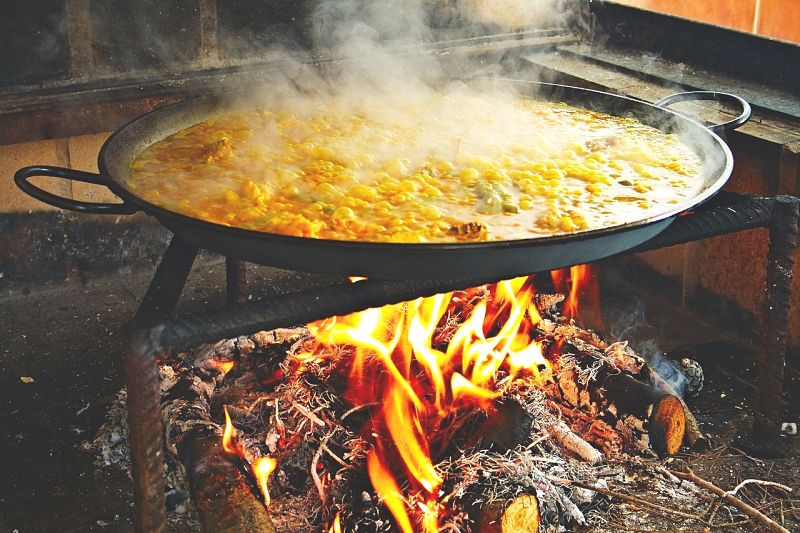
Classic Seafood Paella with Fresh Herbs
Ingredients
- 12 mussels
- 10 thyme sprigs
- 1 head of garlic
- 600 g (21 oz) clams
- 12 large green prawns
- 1/2 cup chopped parsley
- 12 lemon wedges, for serving
- 400 g (14 oz) paella rice or similar
- 1/2 good quality extra virgin olive oil
- 2 medium size brown onions, finely diced
- 1 cup broad beans, green beans (or peas),
- salt and freshly ground black pepper to taste
- 5 medium tomatoes, peeled, de-seeded and diced
- 500 g (1 lb) firm white fish fillets, cut into cubes
- 400 g (14 oz) cleaned calamari tubes, sliced into rings
- 5 cups fish stock combined with 1 tablespoons tomato paste
- 2 medium red capsicums or one large one, de-seeded and diced
- 2 medium green capsicums or one large one, de-seeded and diced
- 1/4 cup fish stock combined with 1/2 tablespoon toasted saffron
Method
You need a large paella pan or shallow thin metal frying pan, about 45 cm (17 inches) at the base, for the volume of this recipe.
Heat the paella pan over low heat. Add the head of garlic and pour a little olive oil over it. Then, add the diced onion, thyme and stir fry for about 5 minutes. Add the green and red and green capsicum and continue stir frying for about 10 minutes. Add the tomato and rice and stir for about 3 minutes. Next, add the fish stock portion mixed with the tomato paste and stir through. Add the fish, calamari and the broad beans (or other beans). Assemble the prawns neatly over the top of the rice. Pour in the saffron stock mixture. Then, add the clams and mussels and simmer, partially covered with foil, until the shells have opened, the other seafood is cooked. Check that the rice is cooked. Add more stock if the liquid has evaporated before the rice is cooked. Switch the heat to high for 2-3 minutes the develop the golden crust. Remove from the heat, sprinkle some chopped parsley, cover with tea towels. Set aside to rest for 5-10 minutes before serving with lemon or lime wedges and fresh herbs.
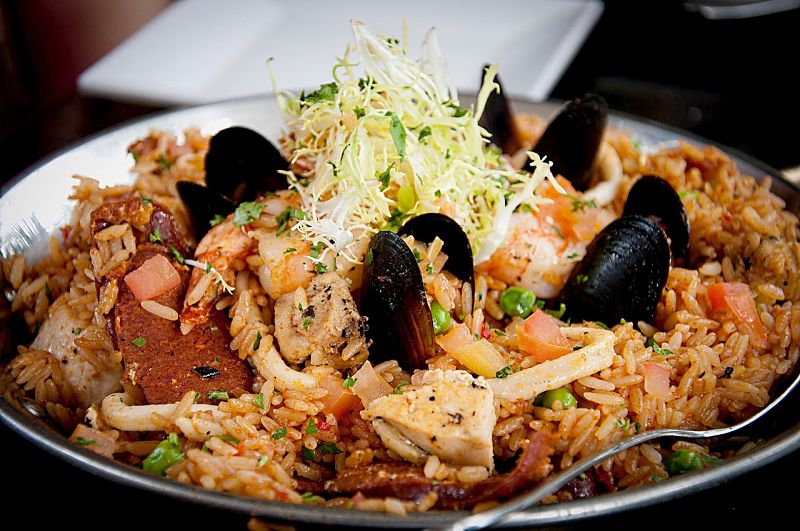
Veggie Paella Recipe
Ingredients
- Sea salt to taste
- 3 teaspoons olive oil
- 1 onion, finely chopped
- 3 teaspoons dried oregano
- generous pinch of saffron
- 50 ml (1/4 cup) white wine
- 1/2 cup fresh herbs to taste
- 2 garlic cloves, finely chopped
- 1/2 teaspoons dried chilli flakes
- 400 ml (1 2/3 cups) vegetable stock
- 2 x 400 g (14 oz) tins plum tomatoes
- Freshly ground black pepper to taste
- 1 red or yellow capsicum (pepper), sliced lengthways
- 250 g (8 oz) short grain rice (eg arborio or Spanish bomba)
- 100 g (3.5 oz) green olives, roughly crushed and stone removed
- 100 g (3.5 oz) baby broccoli (broccolini), sliced on the diagonal
Method
Heat a casserole, a paella dish or a Dutch oven over a medium high heat and add some olive oil. When hot, stir-fry the onion and capsicum for 6-9 minutes until just tender. Stir through the chilli flakes and garlic and continue to cook for 1-3 minutes. Add the wine and simmer for 1-3 minutes. Then, add the vegetable stock, tomatoes, saffron and rice and combine well. Bring the mixture to a steady simmer. When almost all of the liquid has gone, reduce the heat. Cover the pan with a lid and heat gently for 25-30 minutes or until the rice is tender and the rice at the base has started to brown and caramelise. Stir add the olives, fresh herbs and broccoli, stirring into the upper layers, without disturbing the base. Season with sea salt and ground black pepper and serve hot.
